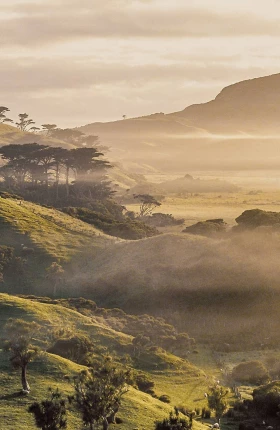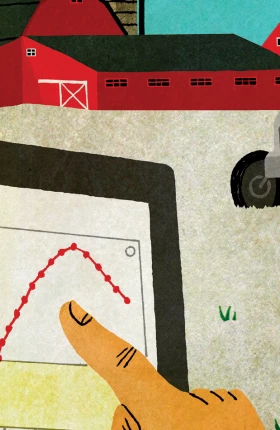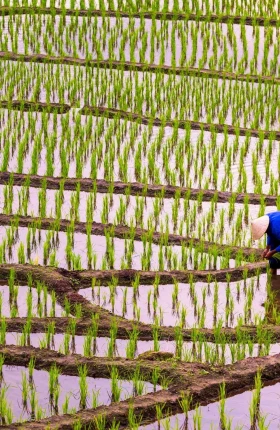A Vision for 2050
Earlier this year, we published ‘The Future of NZ Inc: What Will New Zealand Be Known for in 2050?’ which highlighted the importance of ecosystems in addressing Aotearoa New Zealand’s challenges related to productivity and economic growth.
We suggested five ecosystems that New Zealand could be known for: Agriculture 4.0 (Agritech), Space and Satellites, GreenTech, Creative Industries and the Future of Medicine. This report looks at Agriculture 4.0, specifically agritech – the technology that improves the way we grow, farm, harvest, produce and package food and fibre. We believe it’s the most mature and immediate opportunity for NZ Inc.
This report works towards a vision that by 2050, Aotearoa New Zealand will be a global powerhouse in agritech – a living laboratory and vibrant ecosystem where world-leading research, innovative talent, cultural values and investment converge. Our spirit of ingenuity will power technologies that lead global markets, our start-ups will scale across continents, and our economy will grow through innovation grounded in respect for the whenua (land).
To realise this vision, we need to place a strategic bet on agritech. We also need near-term goals to make it real. Over the next five years, New Zealand needs to start the flywheel – once in motion, it will keep turning; gaining momentum and putting other flywheels into motion.
By 2030, New Zealand’s agritech ecosystem will:
- Double (or more) foreign and domestic investment in agritech – creating a clear, connected entry point for investors seeking to engage with New Zealand’s agritech opportunities.
- Scale homegrown ventures beyond New Zealand – supporting more start-ups to bridge the gap between innovation and international markets.
- Unlock innovation from our universities – turning research excellence into real-world solutions through strong commercialisation pathways and partnerships.
- Cultivate the next generation of talent – specialising our universities and strengthening STEM education so students can grow their agritech futures in New Zealand.
- Embed Māori cultural values – integrating kaitiakitanga and long-term stewardship into the fabric of New Zealand’s agritech value proposition, setting us apart as a nation that innovates with purpose and enhances the role of kaitiaki who maintain the enduring vitality of the whenua.

We identified 15 actions to close the most material gaps in New Zealand’s agritech ecosystem and enable it to thrive. They are prioritised by expected impact and ease of implementation, and address capital and investment barriers, Māori-specific structural constraints, talent development, and retention and regulatory complexity.
Quick wins (high impact/easier to execute)
- Expand agritech-focused co-investment programmes, such as the Elevate NZ Venture Fund and Sustainable Food and Fibre Futures initiative with dedicated agritech mandates to bridge Series A-C funding gaps.
- Target agritech foreign direct investment (FDI) by using an orchestrator to facilitate roadshows and structured co-investment offers.
- Encourage commercialisation of university ventures by removing the mandatory university ownership stake and establishing a near-term funding mechanism for university technology transfer offices.
- Provide tailored capital for Māori agritech ventures, including blended finance and co-investment aligned to whenua governance and kaupapa Māori.
- Enable iwi-led partnership ventures on whenua; for example, structured joint-ventures with agritech firms (e.g. precision land use, vertical farming and bioactives).
Bold bets (high impact/harder to execute)
- Bolster agritech-specific STEM pathways, by embedding agritech in schooling, expanding micro-credentials and scaling work-integrated learning.
- Establish agritech regulatory sandboxes and policy co-design pilots, such as safe zones to trial new technologies and safe-harbour zones to test frontier technologies like gene editing and biostimulants in real farm settings.
- Fast-track an agritech regulatory pathway to market for emerging agritech fields and establish a virtual clinic to connect startups with the Ministry for Primary Industries, the EPA and regional authorities for pre-consent guidance.
Low-hanging fruit (straightforward/incremental impact)
- Fund regional innovation hubs that bring together researchers, startups, growers and Māori organisations to design and test agritech solutions and provide ‘innovation-as-a-service’ for global partners.
- Require secondary school STEM education to build a stronger pipeline of talent for New Zealand’s agritech sector and other industries and guide students to fill emerging talent gaps.
- Accelerate digital agritech training pathways and micro-credentials to rapidly upskill talent in data, AI and robotics and increase Māori participation with kaupapa-aligned pathways.
- Institutionalise an agritech orchestrator to coach startups – a neutral national hub that supports startups to become investor-ready and provides a mentor network, regulatory clinic and public venture map.
Strategic long shots (harder/longer-dated impact)
- Embed Māori culture and traditional knowledge systems in agritech intellectual property (IP) and design with co-governed protocols that integrate the Māori world view into R&D, product design and IP systems.
- Broker collective investment in shared agritech infrastructure by supporting business owners and Māori landowners to pool capital and demand for shared assets (e.g. IoT networks, pilot plants and bioactives testing).
- Launch agritech returnee fellowships for New Zealand diaspora, offering relocation support, matched startup finding and pathway visas to back returnee founders and leaders.
The Path Forward
At the beginning of this series, we asked 'what will Aotearoa New Zealand be known for in 2050?' We are confident in agritech as one answer to that question. Agritech is New Zealand’s opportunity to lead on the global stage and stimulate economic growth, but we will only capture this opportunity if we move together as one ecosystem, not a collection of isolated efforts.
Government has an enabling role, but enduring success must be ecosystem-led and industry-driven. What’s needed now is collective action – alignment between entrepreneurs, investors, universities, researchers, iwi and industry. Where public support is needed, we will be clear and specific – but it is time for the private sector to lead with purpose, investment and confidence.
The green shoots are already here: we have a research capability with a global reputation, strong Māori enterprise, global credibility and a generation of innovators ready to lead. Now is the moment to come together – to grow the technologies, talent and trust that will make Aotearoa New Zealand the world’s agritech leader. Tīhei mauri ora.









